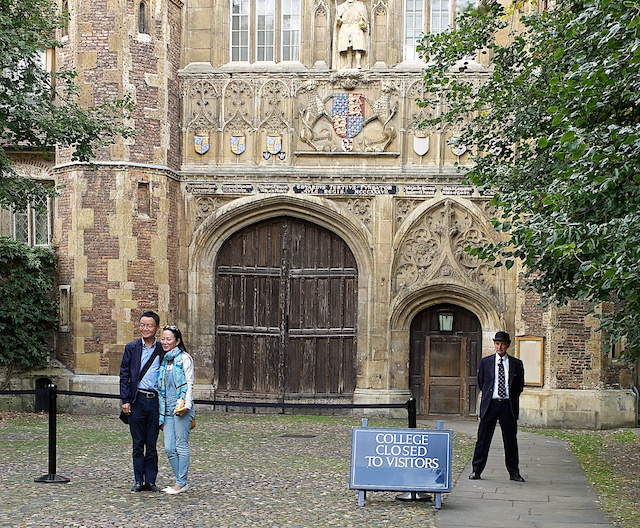One of the most picturesque towns in Provence (IMHO). Luberon hills in the distance.
How to illustrate a point
I had a nice email from a colleague in India about my Observer column on the surveillance-based business model of the contemporary Web.
Excellent piece today John on surveillance being the revenue model of the Net.
When I read your piece, what was the banner ad on the Observer page? Jet Airways fares from Bombay to Delhi?
And what was one of the things I was looking for on the net earlier today…the price of air fares from Bombay to Delhi…including on Jet Airways.
Neat, eh?
The economics of Ebola
As someone who has written 50 newspaper columns a year for as long as I can remember, I know a really skilled practitioner of the columnist’s art when I see one. And one of the best is James Surowiecki of the New Yorker whose weekly ‘Financial Page’ is one of the wonders of the journalistic world. It’s not only unfailingly intriguing and informative, but it’s also clear and beautifully written.
Last week’s page on the economics of Ebola (and the economics of drug-discovery generally) is a typical gem. Surowiecki starts from the puzzle that while Ebola is one of the deadliest diseases known to mankind, nevertheless the pharmaceutical industry has developed no serious tools to combat it.
He then goes on to point out that this is only a puzzle to those who do not understand how the pharmaceutical industry works. “When pharmaceutical companies are deciding where to direct their R.& D. money”, he writes
very naturally assess the potential market or a drug candidate. That means that they have an incentive to target diseases that affect wealthier people (above all, people in the developed world), who can afford to pay a lot. They have an incentive to make drugs that many people will take. And they have an incentive to make drugs that people will take regularly for a long time – drugs like statins.
This system does a reasonable job of getting Westerners the drugs they want (albeit often at high prices). But it also leads to enormous underinvestment in certain kinds of diseases and certain categories of drugs. Diseases that mostly affect poor people in poor countries aren’t a research priority, because it is unlikely that those markets will ever provide a decent return. So diseases like malaria and tuberculosis, which together kill two million people a year, have received less attention from pharmaceutical companies than high cholesterol. Then, there’s what the World Health Organisation calls “neglected tropical diseases”, such as Chagas disease and dengue; they affect more than 1 billion people and kill as many as half a million a year. One study found that of the more than fifteen hundred drugs that came to market between 1975 and 2004 just ten were targeted at these maladies. And when a disease’s victims are both poor and not very numerous that’s a double whammy. On both scores, a drug for Ebola looks like a bad investment: so far, the disease has appeared only in poor countries and has affected a relatively small number of people.
This is, of course, bad news for people in poor countries. But Surowiecki goes on to point out that the business model of pharmaceutical companies poses serious risks for those of us who live in rich countries too. The case study he picks is the looming problem of diseases that have become resistant to our current arsenal of antibiotic drugs. The need for new, more powerful antibiotics grows with every passing day, but it’s not need that the industry – left to itself – will be able to address.
The trouble, again, is the business model. If a drug company did invent a powerful new antibiotics, we wouldn’t want it to be widely prescribed, because the goal would be to delay resistance. Public-health officials would – quite properly – try to limit sales of the drug as much as possible. Otherwise its efficacy would follow the same downward path as conventional antibiotics.
Which leaves us with a difficult public-policy problem: how can we get the drugs we will need without radically transforming the industry that makes them? The answer has to be some way of incentivising companies to do the research necessary to create substantial public-health benefits. And the only idea we seem to have for doing that at the moment is by going back to what the Board of Longitude did in the 18th century — getting governments to offer massive prizes for drugs that we may need but for which there is only a limited immediate market.
It’s a great column, worth reading in full.
The hitching post
The Leica phenomenon
Photograph by Antonio Olmos for the Observer.
My Observer essay marking the centenary of the Leica camera.
I’m a photographer. No, let me rephrase that: I would like to be a photographer. In reality I’m merely an obsessive who takes lots of photographs in the hope that some day, just once, he will produce an image that is really, truly memorable. Like the images that Henri Cartier-Bresson captured, apparently effortlessly, in their thousands. Think, for example, of his famous picture of the guy leaping over a puddle; or the one of the two stout couples enjoying a picnic on the banks of the Marne; or his magical picture of a cheeky young boy carrying two bottles of red wine on the Rue Mouffetard in 1954. I like this last one particularly, because the lad in the photograph is about the same age as I was then and I often wonder if he’s still around, and what he looks like now.
You can think about this obsessiveness, this quest for the one perfect picture, as a kind of illness. If so, then I’ve had it for more than half a century. And I’m not the only sufferer…
Closure
Web services are ‘free’, which is why we’re all in chains
This morning’s Observer column.
‘Be careful what you wish for,” runs the adage. “You might just get it.” In the case of the internet, or, at any rate, the world wide web, this is exactly what happened. We wanted exciting services – email, blogging, social networking, image hosting – that were “free”. And we got them. What we also got, but hadn’t bargained for, was deep, intensive and persistent surveillance of everything we do online.
We ought to have known that it would happen. There’s no such thing as a free lunch, after all…
Shorts
The boardwalk
TOR, Taylor Swift and breaking the Kafkaesque spiral
Photo cc https://secure.flickr.com/photos/comedynose/7865159650
Ever since the Snowden revelations began I’ve been arguing that Kafka is as good a guide to our surveillance crisis as is Orwell. The reason: one of the triggers that prompts the spooks to take an interest in someone is if that person is using serious tools to protect their privacy. It’s like painting a target on your back.
So if you use PGP to encrypt your email, or TOR for anonymous browsing, then you are likely to be seen as someone who warrants more detailed surveillance. After all, if you’ve nothing to hide… etc.
And there’s no way you would know that you had been selected for special treatment. This sounds like a situation that Kafka would recognise.
Until the other day, I couldn’t think of a way out of this vicious cycle. And then I came on reports (e.g. here) that a musician of whom I’d never heard — electronic music artist Aphex Twin — had announced the details of his new album on a site only accessible through Tor.
This resulted in the page attracting 133,000 views in little over 24 hours. This is within the limits of what TOR can currently handle, but Tor’s executive director, Andrew Lewman, worries that a more mainstream artist could break the system in its current state.
“If tomorrow, Taylor Swift said ‘to all my hundreds of millions of fans, go to this [Tor] address’, it would not work well. We’re into the millions now, and we have a few companies saying ‘we want to put Tor as a privacy mode in our premier products, can you handle the scale of 75-100m devices of users’, and right now the answer is no, we can’t. Not daily.”
This sounds like — and is — a problem. But it’s also an opportunity. Because what we need is for encrypted email and anonymous browsing to become the norm so that the spooks can’t argue that only evil people would resort to using such tools.
And here’s where Aphix Twin and Taylor Swift come in. They have the power to kickstart the mainstreaming of TOR — to make it normal. Of course for that to be effective it means that TOR has to be boosted and expanded and securely funded. Just as the big Internet companies have finally realised that they have to chip in and support, for example, the OpenSSL project, so they should now chip in to help build the infrastructure that would enable TOR to become the default was we all did web browsing.







